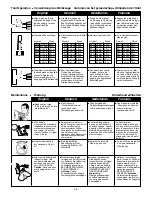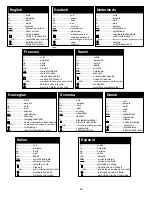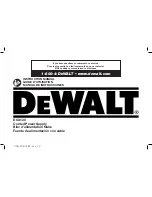
Tool Operation
l
Verwendung des Werkzeugs
Gebruik van het gereedschap
l
Utilisation de l’Outil
English
Deutsch
Nederlands
Francais
30
l
(3) Laat de motor draaien.
De volgende schroef
wordt automatisch
aangebracht wanneer het
gereedschap tegen het
werkvlak wordt gedrukt.
l
(1) Den Auslöseknopf
ziehen, um den Motor zu
starten. (2) Das Nasenstück
mit gleich bleibender Kraft
gegen die Arbeitsfläche
drücken. Das Werkzeug
erst von der Arbeitsfläche
nehmen, wenn die
Kupplung ausrückt und das
Bit zu drehen aufhört, was
eine vollständig eingedrehte
Schrauben anzeigt.
l
(1) Druk de trekker in
om de motor te starten.
(2) Druk de neus met
constante kracht tegen
het werkvlak. Verwijder
het gereedschap niet
van het werkvlak voor
de koppeling lost en de
bit stopt met draaien: de
schroef is nu volledig
ingedraaid.
l
(3) Den Motor weiter
laufen lassen. Die nächste
Schraube wird automatisch
eingerückt, wenn das
Werkzeug gegen die
Arbeitsfläche gedrückt wird.
l
Das Werkzeug besitzt eine
Tiefeneinstellung.
l
Mit einer Schraube einen
Versuch durchführen,
bevor die Tiefe endgültig
eingestellt wird, um die
geeignete Senkung der
Schraube sicherzustellen.
l
Die Senkung der Schraube
mit dem Rändelrad
einstellen: Das Diagramm
auf dem Werkzeug gibt
entsprechende Hinweise.
l
Dit gereedschap is
voorzien van een
afstelbare diepteregeling.
l
Breng bij wijze van proef
één schroef aan voor u
de diepte definitief afstelt,
om te zorgen dat de kop
goed wordt verzonken.
l
Stel de verzinkdiepte
bij door aan het wieltje
van de diepteregeling
te draaien. Raadpleeg
de afbeelding op het
gereedschap voor de
juiste richting.
l
(1) Pull the trigger to start
the motor. (2) Press the
nosepiece, with constant
force, against the work
surface. Do not remove
the tool from the work
surface until the clutch
disengages and the bit
stops rotating, signaling a
fully driven screw.
l
(3) Continue to allow
the motor to run. The
next screw will be
automatically fed into
place when the tool is
depressed against the
work surface.
l
This tool is equipped
with a depth control
adjustment.
l
Test drive one screw
before finalizing the depth
to ensure appropriate
countersink.
l
Adjust the countersink
by turning the depth
adjustment thumbwheel:
Refer to the graphics
on the tool for proper
direction.
l
(1) Appuyez sur la
gâchette pour démarrer
le moteur. (2) Appuyez
le nez sur la surface de
travail avec une pression
constante. N’enlevez pas
l’outil de la surface de
travail avant débrayage
et arrêt de la rotation de
la broche indiquant que
l’opération de vissage est
complètement terminée.
l
(3) Appuyez de nouveau
sur la gâchette pour
permettre au moteur de
tourner. La vis suivante
sera automatiquement
alimentée à sa place dès
que vous appuierez l’outil
sur la surface de travail.
l
Cet outil est équipé d’un
système de réglage de la
profondeur.
l
Faites un essai avec une
vis avant de procéder
au réglage final de
la profondeur afin de
vous assurer que la
pénétration est correcte.
l
Réglez la pénétration
en tournant la molette
de réglage de la
profondeur : Référez-
vous au graphique
figurant sur l’outil
pour trouver la bonne
direction.
l
This tool has a depth-
sensing clutch. When
the screw is countersunk
to the pre-set depth, it
automatically disengages
and makes a click or
racheting sound. This
is normal and signals
completion of the drive.
l
When the battery is low
or the drive requires too
much torque, the tool may
stall at the bottom of the
drive (before the clutch can
disengage). Continuous
operation in this manner
can cause over-heating
and permanent damage.
l
Cet outil posséde un
dispositif de mesure
de profondeur avec
débrayage. Lorsque la
vis arrive à la profondeur
prédéterminée, le
dispositif se débraie
automatiquement et
produit un clic, signifiant
que le vissage est
terminé.
l
Lorsque la pile est faible
ou que le vissage deman-
de trop de force, l‘outil
peut se bloquer dans le
fond du trou (avant que le
mécanisme de débrayage
s‘enclenche). Si l‘outil est
continuellement utilisé
de cette façon, il pourrait
surchauffer et subir des
dommages permanents.
l
Dieses Werkzeug hat eine
Kupplung mit Tiefenfühler.
Wenn die Schraube zur
voreingestellten Tiefe
versenkt ist, löst sich die
Kupplung automatisch
und erzeugt ein klickendes
Ratschengeräusch. Das ist
normal und zeigt an, dass
die Schraube vollständig
eingeschraubt ist.
l
Dit gereedschap is
voorzien van een koppeling
met dieptevoeler. Wanneer
de schroef op de vooraf
ingestelde diepte is
verzonken, ontkoppelt
het toestel automatisch
en hoort u een klik of een
ratelgeluid. Dit is normaal
en betekent dat de schroef
volledig ingedraaid is.
l
Bei schwachem Akku oder
zu hohem erforderlichem
Anzugsmoment kann das
Werkzeug gegen Ende des
Eintreibens blockieren (bevor
sich die Kupplung löst). Wird
das Werkzeug über einen
längeren Zeitraum auf diese
Weise verwendet, kann es
überhitzen und dauerhaft
Schaden nehmen
l
Wanneer de batterij bijna
uitgeput is of de aandrij-
ving te veel kracht vraagt,
kan het gereedschap blok-
keren tijdeus het aanbren-
gen (voor de ontkoppeling
in werking dan treden).
Als u het toestel langdurig
op deze manier gebruikt,
kan het oververhit geraken
en blijvend beschadigd
worden.
















































